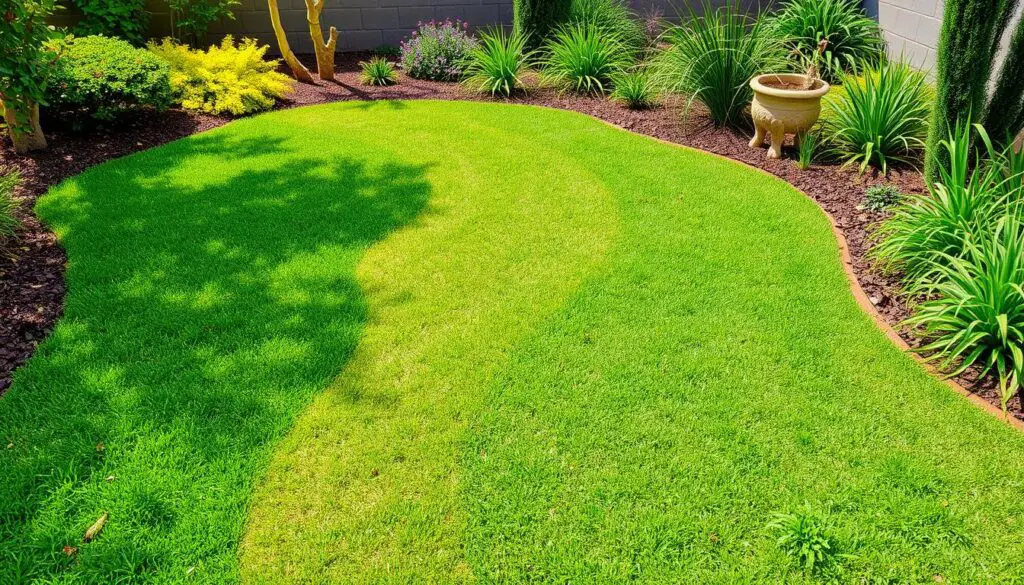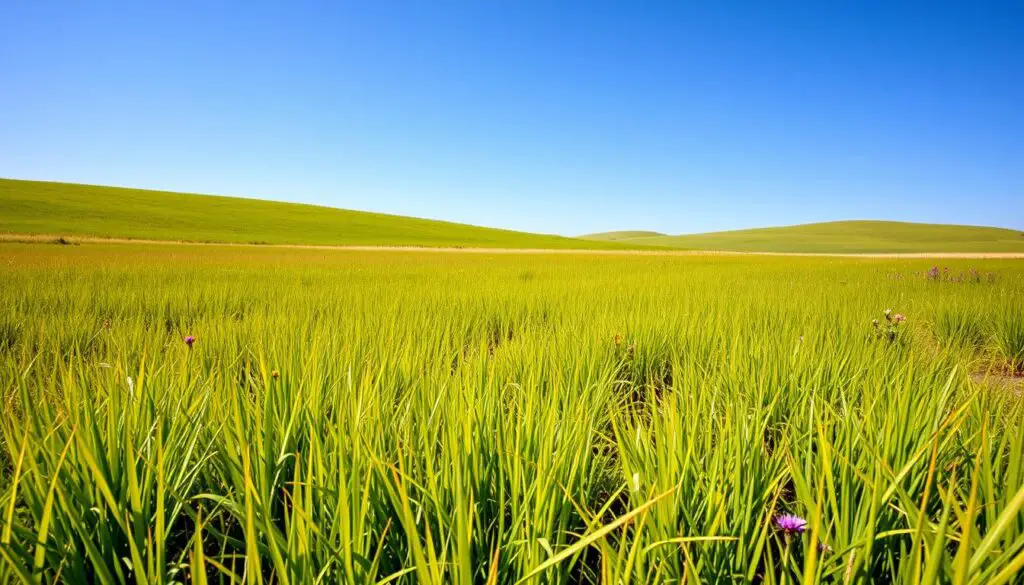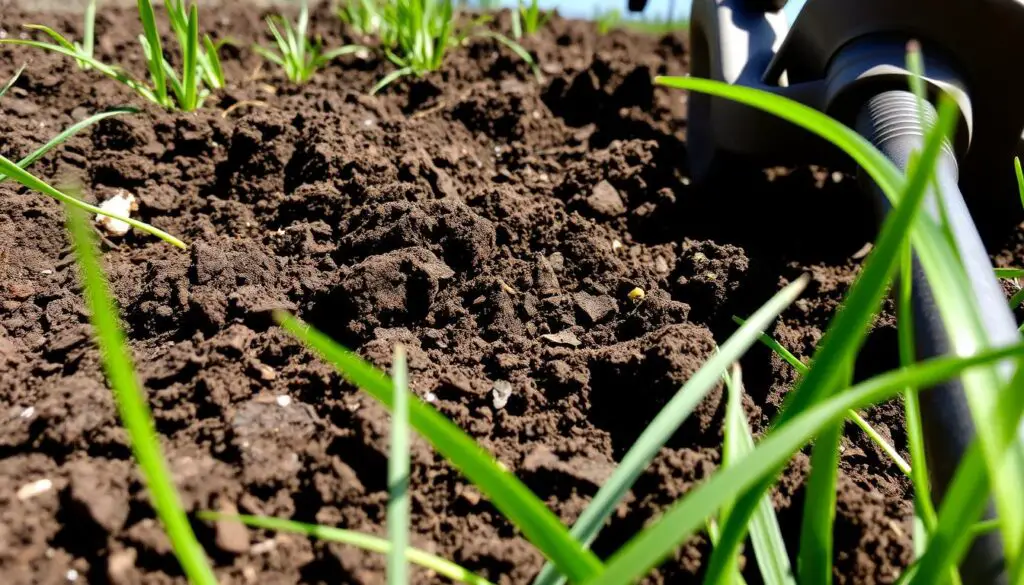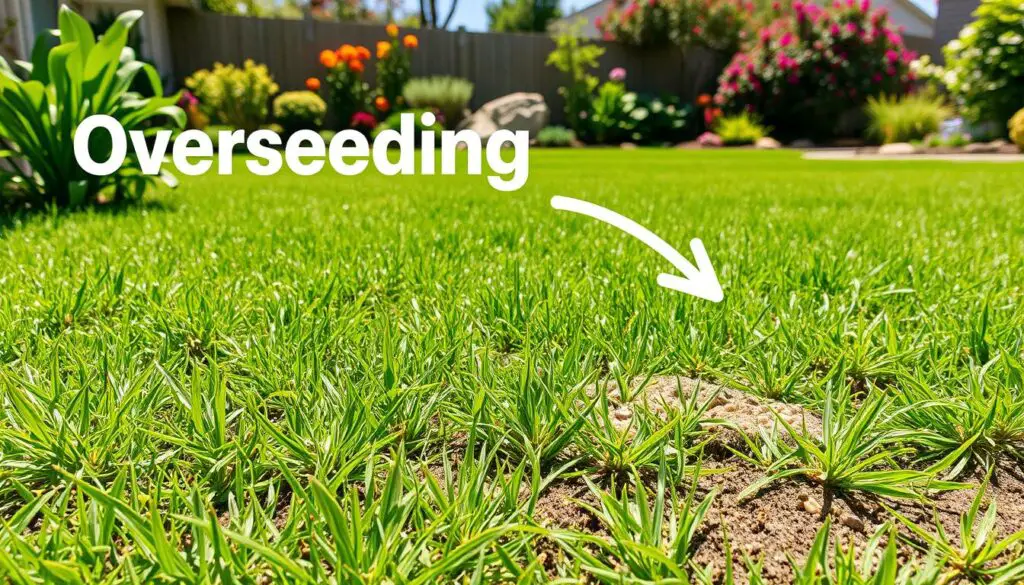How to Choose the Right Grass Seed for Each Climate

Different climates require different types of grass, so it’s important to select the best grass seed for each climate zone.
In New Jersey, the best grass seeds for the northeast are Tall Fescue, Kentucky Blue, Perennial Rye, or Fine Fescue blends. Picking the right grass seed is key for a lush, healthy lawn all year. Whether you’re starting fresh or fixing up your lawn, choosing the right grass for your zone is crucial.
It can make your lawn vibrant and easy to care for, or a constant fight against weeds and bare spots.
Key Takeaways
- Selecting grass seed tailored to your climate zone is essential for lawn success.
- Cool-season grasses like Kentucky Bluegrass and Fescue thrive in northern regions with cold winters and moderate summers.
- Warm-season grasses such as Bermuda and Zoysia excel in high-heat southern climates but struggle with northern winters.
- Drought-tolerant grass varieties like Tall Fescue and Zoysia are well-suited for areas prone to dry conditions.
- Shade-adapted grasses like Fine Fescue can flourish in limited sunlight conditions.
Understanding Grass Growing Zones
Choosing the right grass seed for each climate is essential to ensure your lawn stays healthy and green throughout the year.
Knowing the grass growing zones in the United States is key for a lush lawn. The country is split into areas where cool-season or warm-season grasses grow best. This knowledge helps you choose the right grass seed for your lawn.
Cool-Season Grass Zones
Cool-season grasses like Kentucky bluegrass and fescues do well in cooler areas. They thrive in northern climates with mild summers and cool springs and falls. But, they struggle in the hot south.
Warm-Season Grass Zones
Warm-season grasses, such as Bermuda grass, love the heat but can’t handle cold winters. They’re perfect for the south and Gulf Coast areas.
Transition Zones
The transition zone lies between the cool and warm grass areas. It’s where cool and warm grasses can both grow. Homeowners here often choose warm-season grasses like zoysia for their hardiness.
Knowing your grass growing zone helps pick the best seed for your lawn. This ensures it thrives in your local climate.
Evaluating Your Lawn’s Conditions
Choosing the right grass seed for your lawn starts with knowing its conditions. Factors like sunlight, soil type, and foot traffic are key. These elements help you pick the best grass for your lawn.
By picking the right grass seed for each climate, you can avoid common issues like bare spots and weeds.
Sunlight Exposure
The sunlight your lawn gets is crucial. Grasses like Bermuda and zoysia need at least 6 hours of direct sun. Shade-tolerant grasses, like fine fescues, can do well with 2-4 hours of sun. Check your lawn’s sun levels and choose the right seed.
Soil Type and pH
Soil type and pH affect grass growth. A soil test will show your lawn’s nutrient levels and pH. This info helps pick grass seeds that match your soil. For example, centipede grass likes acidic soil, while Kentucky bluegrass prefers neutral to slightly alkaline.
Foot Traffic and Usage
Think about how your lawn will be used when picking seed. High-traffic areas need tough grasses like tall fescue. Low-traffic spots can have softer grasses like fine fescues. Choose seed based on your lawn’s use for a healthy lawn.
| Grass Type | Sunlight Exposure | Soil Type | Foot Traffic Tolerance |
|---|---|---|---|
| Bermuda Grass | Full Sun | Variety of Soils | High |
| Zoysia Grass | Full Sun to Partial Shade | Variety of Soils | High |
| Fine Fescue | Partial to Dense Shade | Well-Drained Soils | Low |
| Tall Fescue | Full Sun to Partial Shade | Variety of Soils | High |
| Kentucky Bluegrass | Full Sun | Loamy Soil | Moderate |

“Understanding your lawn’s conditions is key to picking the right grass seed for a healthy lawn.”
Cool-Season Grass Options
Cool-season grasses are perfect for lush lawns in northern climates. They do well in cooler temperatures and offer a dense feel. Kentucky bluegrass, perennial ryegrass, and fescue grasses are top choices.
Understanding which grass seed works best for each climate will make your lawn care easier and help your grass thrive.
Kentucky Bluegrass
Kentucky bluegrass is a favorite in northern areas. It grows a lush, green lawn. But, it needs regular mowing, watering, and fertilizing to look its best.
Perennial Ryegrass
Perennial ryegrass grows fast and is durable. It’s great for areas with a lot of foot traffic. It also fights off common lawn diseases well.
Fescue Grasses
The fescue family includes many cool-season grasses. Fine fescues do well in the shade and have a soft look. Tall fescues are good for areas with some foot traffic and can handle drought.
| Grass Type | Climate Suitability | Texture | Maintenance Level |
|---|---|---|---|
| Kentucky Bluegrass | Northern Climates | Dense, Fine | High |
| Perennial Ryegrass | Cool-Season Regions | Medium, Durable | Moderate |
| Fine Fescue | Shaded Areas | Fine, Delicate | Low |
| Tall Fescue | Cool-Season Climates | Coarse, Durable | Moderate |
“Canada is proud to be the world’s largest supplier of Red Fescue cold-weather seed.”
Warm-Season Grass Options
In southern climates, warm-season grasses like Bermuda grass, St. Augustine grass, and Zoysia grass are top picks. They love the heat and humidity found in many southern areas. This makes them a favorite for both homeowners and landscapers.
When selecting grass seed for each climate, be sure to consider factors like temperature, rainfall, and sunlight.
Bermuda Grass
Bermuda grass is tough and does well in hot, sunny spots. It’s great for lawns, sports fields, and golf courses in the Deep South. It might turn brown in winter, but you can overseed it with annual ryegrass to keep it green.
St. Augustine Grass
St. Augustine grass loves the warm, humid weather of southern states. It grows best in sandy, well-drained soils and can handle partial shade. This makes it perfect for coastal areas. It keeps its blue-green color well into fall, adding beauty to any landscape.
Zoysia Grass
Zoysia grass is known for its soft, dense texture and drought tolerance. But, it needs regular care like mowing and soil prep. The hard work pays off, though, as it can make your lawn look like a golf course.
Choosing Bermuda, St. Augustine, or Zoysia grass means a beautiful, easy-to-care-for lawn in the South. These grasses are built for the heat and can handle tough southern weather.

Grass Seed Climate Compatibility
Choosing the right grass seed is key for a lush, easy-to-care-for lawn. The climate compatibility of your grass seed is vital for your lawn’s health. Knowing the growing needs of cool-season and warm-season grasses is essential.
Cool-season grasses like Kentucky bluegrass, perennial ryegrass, and fescues do well in cooler areas. They handle cold winters and moderate summers well. Warm-season grasses, such as Bermuda, St. Augustine, and zoysia, thrive in warmer, more humid climates. They are great for hot summers and offer drought resistance.
Getting your soil tested is a crucial step in picking the right grass. It helps figure out your soil’s pH and nutrient levels. This information guides you to the climate-appropriate grasses for your area.
“Choosing the right grass seed for your climate is the foundation for a healthy, low-maintenance lawn.”
Understanding the needs of different grass types and matching them to your climate ensures a beautiful lawn. With a little research and advice from lawn care experts, you can have a vibrant lawn with minimal effort.
Choosing Grass Seed Blends and Mixtures
Grass seed blends and mixtures can really change the game for your lawn. They mix different grass types to make a strong, flexible lawn. This is great for areas with changing weather or sun and shade.
Some grass seed blends have purity as low as 85%. But GroundMaster’s elite blend has about 70% perennial ryegrass. It’s perfect for busy lawns. The Wet Soils Mixture, with Tall Fescue, is great for clay soils and is easy to care for.
For shaded spots, Smooth Stalked Meadow Grass is a top pick. It grows well and has a moderate blade width. Perennial Ryegrass is quick to grow, making it great for fast results.
It’s important to pick the right grass seed mix for your lawn. Matching the seed to your soil type helps it grow better. Perennial Ryegrass is good for lawns that get a lot of foot traffic.
| Grass Seed Blend | Key Features | Ideal For |
|---|---|---|
| GroundMaster Elite | 70% Perennial Ryegrass | High-traffic turf |
| Wet Soils Mixture | Tall Fescue | Clay soils |
| Smooth Stalked Meadow Grass | Rhizome-driven growth, moderate blade width | Shaded areas |
| Perennial Ryegrass | Quick germination | Fast results |
Choosing the right grass seed blend can make your lawn look amazing. It will be the talk of the town.
Preparing the Soil for New Grass
Before planting new grass seed, it’s crucial to test your soil and address any imbalances. A soil test will show the soil’s pH, nutrient levels, and any needed amendments. This creates the best growing environment for your new lawn.
Soil Testing
A soil test is a valuable tool that provides insights into your soil’s composition. It can spot issues like low pH, nutrient deficiencies, or high levels of certain minerals. With this info, you can choose the right soil amendments and make the necessary adjustments for a thriving lawn.
Tilling and Amending
After getting your soil test results, it’s time to prepare the ground for seeding. This involves tilling the soil to loosen and aerate it. This makes it easier for roots to establish. You might also need to add organic matter like compost or peat moss to improve soil structure and nutrient content. Adjusting the pH with lime or sulfur can also help create the perfect growing conditions for your grass type.
“Proper soil preparation is key to the success of your new lawn. Taking the time to test and amend the soil will pay dividends in the long run.”
By following these steps, you’ll ensure your soil is ready to support the healthy growth and establishment of your new grass seed.

Overseeding an Existing Lawn
If your lawn is thin or patchy, overseeding can help. It involves spreading new grass seed over your lawn. This can fill in bare spots and make your lawn look better.
To overseed your lawn well, you’ll need some tools:
- Lawn mower
- Rake
- Fertilizer spreader
- Grass seed
- Enriched topsoil
- Lawn starter fertilizer
- Dethatcher, power rake, or verticutter (optional)
- Core aerator (optional)
Start by mowing your lawn short and dethatching. Then, aerate the soil. This helps the new seed grow better. Adding enriched topsoil can also help your lawn grow thick and fast.
Choose a grass seed that matches your lawn’s type. This ensures a smooth look. Use a spreader to spread the seed evenly. Make sure to water well after seeding.
The best time to overseed depends on your grass type. Cool-season grasses do well in the fall. Warm-season grasses are best in late spring or early summer.
By following these steps, you can make your lawn look great again. Overseeding is a smart way to improve your lawn’s appearance and health.
| Overseeding Recommendations | Cool-Season Grasses | Warm-Season Grasses |
|---|---|---|
| Ideal Overseeding Time | Fall | Late Spring/Early Summer |
| Seed Application Rate | 4-6 lbs per 1,000 ft² | 4-6 lbs per 1,000 ft² |
| Ideal Soil Temperature | Above 55°F | Above 55°F |
| Watering Recommendations | 15-20 minutes daily for 14-21 days | 15-20 minutes daily for 14-21 days |

Overseeding is a great way to revitalize your lawn. It fills in bare spots and introduces new grass types. With the right preparation and seed, your lawn can become lush and vibrant.
Planting and Establishing New Grass
There are different ways to plant new grass seed for the best results. Broadcast seeding spreads the seed evenly over the soil. Slit seeding uses special tools to place the seed in the ground. The right method depends on your lawn’s size and the grass seed type.
Seeding Techniques
Broadcast seeding works well for big areas because it covers a lot of ground fast. Slit seeding is better for small lawns or areas with existing grass. It helps the seed get in direct contact with the soil for better growth. Always follow the seeding rate for your grass type to get a lush lawn.
Watering and Maintenance
Watering and care are key for new grass seed to grow well. New areas need light, frequent watering until the grass grows. After that, keep the mowing height right and fertilize regularly. This will help your lawn stay healthy and beautiful.
FAQ
What factors should I consider when choosing grass seed for my lawn?
What are the differences between cool-season and warm-season grasses?
How do I determine the right grass seed for my lawn’s sunlight and soil conditions?
What are the key features of cool-season grasses like Kentucky bluegrass, perennial ryegrass, and fescues?
How do warm-season grasses like Bermuda grass, St. Augustine grass, and zoysia grass perform in southern climates?
Why is it important to choose grass seed that is compatible with my regional climate?
When should I consider using a grass seed blend or mixture?
How do I prepare the soil before planting new grass seed?
When should I consider overseeding my existing lawn?
What are the best practices for planting and establishing new grass seed?
Source Links
- https://greenrootsorganic.com/blog/which-grass-seed-is-right-for-my-lawn
- https://kappslawn.com/seeding-success-choosing-the-right-grass-variety-for-your-lawn/
- https://naturesseed.com/blog/best-grass-seed-to-buy/
- https://lawnlove.com/blog/guide-to-transition-zone-grass/
- https://kappslawn.com/late-summer-seeding-for-a-healthier-lawn/
- https://extension.oregonstate.edu/catalog/pub/ec-1550-practical-lawn-establishment-renovation
- https://soandmo.com/blogs/blog/types-of-lawn-seed?srsltid=AfmBOope0bY_ciXIBAiYcRn3vS2lSoXeWaMMLH5l-CwDWctHqJbNe5fW
- https://usawire.com/the-ultimate-guide-to-the-best-lawn-seed-for-a-lush-green-yard-2/
- https://www.greendrop.com/learn/best-cold-season-grasses-for-a-lush-lawn
- https://www.americanmeadows.com/content/clover-grass/how-to/choose-lawn-grass?srsltid=AfmBOoqxOeLdIROCviAigs5cxBEMuXJrP3m7vQ-SIHmrl446ZFqo55cz
- https://growcycle.com/learn/choosing-the-best-grass-seed-for-a-beautiful-resilient-lawn
- https://www.americanmeadows.com/content/clover-grass/how-to/choose-lawn-grass?srsltid=AfmBOoozCVqJIhtCgGbJa_Mm6ESaS3uUkIRGihpq0cgSobK9cCZeNUQn
- https://www.oneneighbor.com/blog/best-grass-types-for-high-traffic-areas
- https://lavingtonturf.com/choosing-the-right-grass-seed-for-the-okanagan-climate-turf-for-local-climate/
- https://www.marcslawn.com/post/choosing-the-perfect-grass-seed-why-it-matters-more-than-you-think
- https://www.greenlandingco.com/post/9-common-mistakes-to-avoid-when-choosing-grass-seed
- https://www.grassseedonline.co.uk/best-grass-seed-for-a-lawn/
- https://lawnlove.com/blog/everything-you-need-to-know-about-grass-seed/
- https://www.homesandgardens.com/gardens/how-to-plant-grass-seed
- https://rohrerseeds.com/blogs/seeds/how-to-plant-grass-seed?srsltid=AfmBOorZ9tafemBhTNoAZr7nZxdvO5qJ_JC-O2Hnuv4y-S8kdRsh-ra3
- https://todayshomeowner.com/lawn-garden/when-to-plant-seeds/
- https://www.lawnstarter.com/blog/lawn-care-2/how-to-overseed-lawn/
- https://weedman.com/resources/lawn-care-library/overseeding-lawn-renovations
- https://www.lawnstarter.com/blog/lawn-care-2/how-to-plant-grass-seed/
- https://naturesseed.com/blog/common-mistakes-made-when-establishing-a-lawn-from-seed/
- https://lawnlove.com/blog/overseeding-in-spring/

